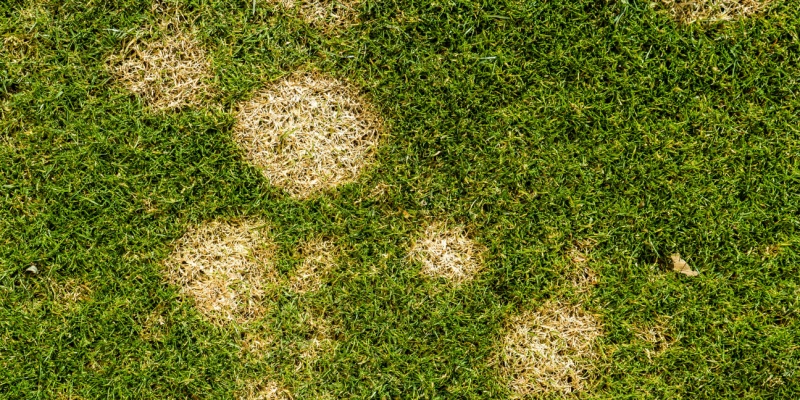Spring in Central Ohio often brings abundant rainfall, creating both opportunities and challenges for Columbus homeowners. While moisture is essential for lawn growth, excessive rain can lead to various issues that require special attention. At Weed Busters, we understand how our local climate affects your lawn and have developed strategies to help your grass thrive despite unpredictable spring weather.
The Impact of Excess Moisture on Your Lawn
Soil Compaction Intensifies
Central Ohio’s clay-heavy soils are particularly susceptible to compaction when saturated. As rainwater fills the spaces between soil particles, foot traffic and equipment can compress the soil more easily, reducing air exchange and hindering root growth. This compaction creates an environment where grass struggles but certain weeds thrive.
Nutrient Runoff and Leaching
Heavy spring rains can wash away recently applied fertilizers before they’re absorbed, or leach nutrients deeper into the soil beyond the reach of grass roots. This not only wastes your lawn care investment but can also contribute to water pollution in local watersheds.
Fungal Diseases Flourish
Prolonged moisture on grass blades creates ideal conditions for fungal pathogens. Common spring lawn diseases in Columbus include:
- Red Thread: Appears as pinkish-red threads through grass blades
- Dollar Spot: Creates straw-colored spots about the size of a dollar coin
- Leaf Spot: Causes dark lesions on grass blades that can lead to thinning
If left untreated, these diseases can cause significant damage to your lawn during the critical spring growth period.
Shallow Root Development
When surface moisture is constantly available, grass roots have little incentive to grow deep. This creates a lawn with poor drought tolerance that will struggle during the inevitable dry spells of summer.
Smart Strategies for Managing Spring Moisture
Adjust Your Mowing Schedule
During periods of heavy rainfall:
- Raise your mowing height by ½ inch to increase photosynthesis and root strength
- Wait until grass is relatively dry to mow—cutting wet grass can spread disease and cause turf damage
- Sharpen mower blades to ensure clean cuts that heal quickly
- Consider mowing more frequently but removing less grass height to avoid stress
Timing Is Everything: Lawn Care Adjustments
- Fertilization: Delay applications until a relatively dry period is forecast, then use slow-release formulations that won’t wash away easily
- Weed Control: Choose rainy-day-resistant herbicides with shorter required dry times
- Seeding: While moisture aids germination, excessive rain can wash away seed—wait for moderate conditions or use erosion-control seed coverings
Address Drainage Issues
Poor drainage exacerbates all rain-related lawn problems. Consider:
- Installing French drains in persistently soggy areas
- Grading to redirect water flow away from flat or depressed areas
- Core aeration to improve water infiltration and reduce surface pooling
- Adding organic matter to clay soils to improve structure and drainage
Fungal Disease Prevention and Treatment
- Apply preventative fungicides before extended rainy periods if your lawn has a history of disease
- Improve air circulation by thinning dense landscape plantings around lawn edges
- Remove excessive thatch that holds moisture against grass blades
- Avoid evening watering once rains subside—morning watering allows grass to dry during the day
Lawn Recovery After Extended Wet Periods
Once the weather improves:
- Perform core aeration to relieve compaction and improve oxygen flow to roots
- Apply a light topdressing of compost to restore microbial activity
- Overseed thin areas using grass varieties with good disease resistance
- Apply a balanced fertilizer to restore nutrients lost to leaching
The Weed Busters Approach to Spring Moisture Management
Our comprehensive spring lawn care programs are designed with Central Ohio’s unique climate in mind. We:
- Monitor weather forecasts to optimize treatment timing
- Use professional-grade products with enhanced rain resistance
- Adjust application rates and methods based on soil moisture levels
- Provide customized solutions for lawns with specific drainage issues
When to Take Action
The key to managing spring moisture is proactive response. Contact Weed Busters for a lawn evaluation if you notice:
- Standing water that remains 24+ hours after rainfall
- Yellowing or thinning grass despite adequate moisture
- Visible fungal growth or discoloration
- Unusually soft, spongy turf
While we can’t control the weather, we can certainly manage its effects on your lawn. With the right approach, your Central Ohio lawn can benefit from spring rains rather than suffer from them. Let Weed Busters help you develop a custom lawn care strategy that accounts for our region’s unique seasonal challenges.

